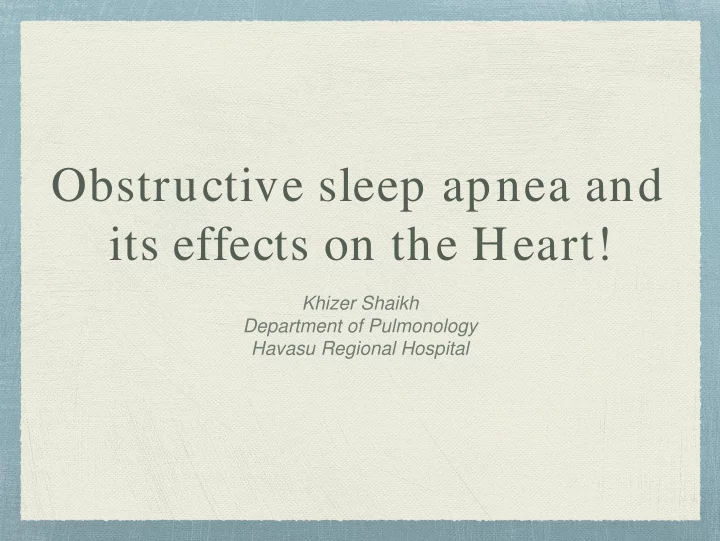

Obstructive sleep apnea and its effects on the Heart! Khizer Shaikh Department of Pulmonology Havasu Regional Hospital
Definitions Demographics Pathophysiology Risk factors Symptoms Determining Severity Systemic effects Effects on the Heart
Repetitive cessation (Apnea) or reduction ( Hypopnea) of airflow during sleep despite respiratory efforts Due to complete (Apnea) or partial ( Hypopnea) airway occlusion during sleep Is this you?
24% of adult men and 9% of adult women Gender Males> Females Prevalence in women increases with menopause
Think of your upper airway as a cylinder.. Determinants of air flow Difference of upstream pressure and downstream pressure Airway resistance Upper airway patency determined by balance of Maintain airway opening ( dilator muscles) Promote airway closure ( decreased intraluminal pressure and Bernoulli Forces) Airway size influenced by lung volume that decreases during sleep
While you are asleep… Mechanism of Obstruction - Upper airway is a collapsable cylinder
Alcohol Sedatives Obesity Aging
Repetitive upper airway obstruction is associated with …. Snoring (alternating with periods of silence) Fall in SaO2 Arrythmias Decrease HR during obstruction Increase HR during apnea termination Arousal at apnea termination Increased Blood pressure during post apnea period
Family history of OSA Male Gender Menopausal state Aging Race (AA, Mex -A, Asians and Pacific islanders) Excess body weight
Daytime sleepiness (most common) Repeated awakenings with gasping or choking Snoring, morning headaches Witnessed apneas Attention deficit Changes in mood Dry mouth/ throat Fatigue, Reflux, Insomnia
Is your doctor screening you?
APNEA-HYPOPNEA INDEX ( AHI) Mild 5-15 Moderate 15-30 Severe >30
Other factors that influence the clinical severity of OSA Degree of daytime sleepiness Lowest SaO2 Severity of sleep fragmentation Nocturnal arrhythmias Co-morbid cardiovascular or neurological disorders
Cardiovascular Respiratory Renal Gastrointestinal Endocrine Neuro-cognitive Immunity
OSA is a risk factor for HTN independent of known confounding factors Increase in SBP and DBP Loss of nocturnal fall in BP ‘ dipping’ phenomenon Risk of cardiovascular disease is increased..
Wisconsin Sleep Cohort Study (709 participants followed over 4 years) The OR for presence of HTN at 4 year follow up AHI (0-5) - 1.42 AHI (5-15)- 2.03 AHI >15 - 2.89
Improvement in BP during CPAP therapy in persons with OSA and HTN Meta-analysis of RTC (1980-2006) 16 trials; 818 subjects Compared to controls, mean net change with CPAP SBP 2.46mm Hg DBP 1.83mm Hg MAP 2.2mm Hg
1/ 3rd of patients with heart failure will have OSA LV systolic dysfunction is an independent risk factor for OSA OSA may contribute to worsening LV dysfunction Higher mortality with untreated OSA 24% vs 12% ( J Am Coll Card 2007)
CPAP therapy improved Left Ventricular ejection fraction in persons with acute heart failure and OSA
Ventricular arrhythmias Frequency of PVCs during sleep decreased by 58% with CPAP Atrial fibrillation Decreased recurrence after cardioversion with CPAP ( 82% vs 42%)
Increased risk in middle aged adults with OSA Independent of age, BMI, BP and smoking Reduced by reversal of OSA ( J Chest 1996) Sleep Heart Health Study 16% of patients with OSA reported 1 more major event MI or angina Coronary re-vascularization HF or Stroke
Possible mechanisms for greater risk of heart disease in patients with OSA Endothelial dysfunction Hyper coagulable state Increased plasma fibrinogen levels Increased platelet activity Decreased fibrinolytic activity Insulin resistance Increased inflammatory markers Increased sympathetic activity Marked sleep related hypotension ( low BP)
At a mean follow of 10.1 years Untreated severe OSA significantly increased the risk of fatal and non fatal cardiac events compared with health controls In treated OSA patients the incidence of fatal and non fatal events was decreased by 50%
General population Sudden cardiac death peaks from 6am to noon Patients with OSA Peaks from midnight to 6am
Avoidance of alcohol, smoking and muscle relaxants Sleep hygiene Safety counseling Optimal Weight management CPAP therapy, Oxygen therapy, Drugs Dental devices Upper airway surgery Tracheostomy
Recommend
More recommend